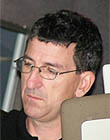|
|
This topic comprises 3 pages: 1 2 3
|
|
Author
|
Topic: Slate Magazine predicts the end of projectionists
|
Cassandra Palko
Film Handler

Posts: 30
From: Menomonee Falls, WI USA
Registered: Jul 2009
|
 posted 12-07-2010 12:56 PM
posted 12-07-2010 12:56 PM





I read Slate for many articles - this is the only one I've ever seen about movie projection. It reminds me of the article recently posted from the New York Times:
Why projectionists soon will be no more
The End
Why projectionists will soon be no more.
By Grady HendrixPosted Monday, Dec. 6, 2010, at 7:12 AM ET
More people die in a movie theater than you would think. "I was at a theater and the manager came up to the booth and said there'd been four shows that day and this guy had sat through three of them. I went downstairs, sat down next to him, and sure enough, he was dead," says Joe Rivierzo, a projectionist. "I called the paramedics and told them that the man is dead, there's no question about that, and I'm going to bring the house lights up just a little and please just carry him out of the theater. So they did. No one really noticed; they just thought he was having a bad day. The show kept playing."
Rivierzo has been a projectionist for 30 years. His father was a projectionist. His grandfather was a projectionist. Between them, they've seen it all. "In the '60s there was a screening of Frankenstein. Projectionist dies right in the middle of the movie. They call one projectionist after another, saying, 'This guy's died. Can you finish the show?' and none of them want to do it. Finally they reach my father, and they don't tell him anything; they just say the guy can't finish his shift, can you fill in? My father goes up, and the guy is lying there on the floor of the booth. He knows this guy, and he has to keep stepping over his body to do the changes while they wait for the coroner to arrive. He's up there, alone in the booth, playing a horror movie and stepping over his good friend's body."
And where there's death, there's sex. Jose Ramos has been the projectionist at the Anthology Film Archives since the '90s, but his career started back in the '80s in New York City's porno houses. "I remember one time I had a break in the film," he says. "I forgot where I was and turned on the lights like I was in a normal theater. You could hear everyone screaming, because the porno houses were just about backdoor sex. At the Roxy, I used to have to do the music and the lights for the strip show and the live sex acts. It was wild times. The strippers would change clothes in my booth to get away from the tricks, and you'd get to know each other. We're all just people, regardless of our chosen profession."
But these days, stripping is thriving while projectionists have fallen on hard times. In an age when studios claim that box-office salvation will be found in new projection technology like Imax and 3-D, projectionists themselves are facing complete and total annihilation.
Rivierzo is an executive board member of Local 306 in New York City, the last uncombined projectionists union in the country. At the height of its power in the '40s and '50s, it had 3,000 members. These days, it's down to 400, and that number's dropping fast, which makes no sense because currently there are more theater screens in the United States than at any other point in history.
But nowhere is technology eliminating the need for human labor faster than in motion-picture projection. From the birth of cinema until the 1960s, the system was the same: Every projection booth had two reel-to-reel projectors with carbon arc light sources. The movie would start playing on one machine, and the projectionist's job was to watch for the changeover cues: usually a small circle or an X in the upper right-hand corner of the screen.
"You see those cues all your life," Ramos says. "Some people know what they are, and some people don't. There's two of them: There's the machine cue, and you already have your reel threaded up to seven or eight on the countdown reel, and when you see the first one, you hit the switch and the second machine starts to run, and when you see the second cue, you step on the pedal or flip a switch, and this projector shuts down and that one starts up. If you do it smooth, it's seamless; if you do it wrong, it f---s up."
Getting a lamp that was bright enough to throw a projected image onto a screen hundreds of feet away was a huge problem, and the first solution was the carbon arc. Two carbon electrodes are brought together, they touch and are then pulled apart, creating a brightly burning arc. The strong, steady light would bounce off a reflector and toward the lens.
"You had to keep them a certain distance from each other," Ramos says. "There were mechanisms in there that moved the rods, but they weren't always reliable because a lot of these machines were really old. The bigger theaters had thicker arcs, and the smaller ones had smaller arcs, and we would monitor it. All the theaters had two lines drawn on the ceiling because the reflection would hit the ceiling, too, and when you saw that the light was going off the ceiling lines, you would have to adjust it."
Then, in the late '60s, projectors started switching to xenon bulbs. These were expensive, sometimes running up to $1,000 each, but they provided a strong, steady light source that didn't need to be monitored. And for Rivierzo, this was the beginning of the end.
"Most guys will say the problems started with platters, but I would argue it was xenon bulbs. Before that, it was a reel-to-reel system, and it was labor intensive because you had to change the film every 20 minutes, and you had to change the carbon. Once they were able to get over that hurdle and get a dependable, inexpensive bright white light, they could come up with a system to feed the film forever."
And they did. Platters appeared in the mid-'70s and, suddenly, instead of two projectors showing individual 20-minute reels of film, projectionists were taking all the individual reels and building them into one monster reel that lay on its side on a spinning platter, and the entire film would feed through a single projector. Films would still have to be built—assembled from individual reels into platters—but with no need for reel changes and a consistent light source, projectionists were no longer needed to run the movies. The unions tried to hold back the inevitable, but chain theaters wanted to get away from expensive union contracts, and the first thing to go were licensing standards.
"Giuliani came in and started to change things to be more favorable to management, and we sensed it was going to be a problem," Rivierzo says. "They wanted to get rid of the projectionist license completely. We fought it at city council, and eventually what they did was water down the test so anyone could pass it."
"Before, you used to have to take a 100-question exam to become a licensed projectionist," Ramos says. "And you had to know electricity, you had to know your currents and your storage and so forth, and you also took a practical exam. But they dumbed it down to a 40-question exam, and the department of consumer affairs took over testing rather than the bureau of gas and electricity. So managers were able to get their license and run the theater, run the box office, run everything, for ten bucks an hour."
As multiplexes put mom-and-pop theaters out of business, the number of movie screens increased while the number of individual theaters decreased. For the companies running chains, movie theaters were machines designed to make money, and the biggest concession they received from the union was the ability to hire fewer projectionists.
"For a 12-screen multiplex, one projectionist will work," Ramos says. "He might get help on 'make and break day,' usually Thursday, when another projectionist comes in for about six hours and helps him build the new films and break down the old ones. But otherwise, it's just one guy. You set the timer to start the show, you set the type of sound system you have for the soundtrack, and you leave it. You walk around to make sure it's running, but with 14 screens, it's impossible to be in all of them at the same time."
To get more out of each projectionist, the chain multiplexes are standardized. Says Rivierzo, "There's automation. There's status boards that'll tell you what's running, what's down, and what has to be threaded. Most multiplexes put all their screens on one floor to make it easier for one projectionist to check them. And some theaters are laid out exactly the same, AMC theaters in particular, you can close your eyes in Chicago or New York and know exactly where you are in the house. Even the way the panels are put in; they use the same equipment."
Ironically, as movie theaters tout their state-of-the-art projection facilities, like Imax and 3-D, they no longer have the staff to ensure that the equipment is maintained. Imax and 3-D require extremely bright light sources, and when the projector bulbs start to fade, the image on the screen dims. Avatar may have cost millions to make, and it may require state-of-the-art equipment to project, but if the $1,000 bulb is old, all those expensive images will look like mud. And with fewer projectionists, there's less quality control.
"Some theaters used to change the bulb with every new show that came in," Ramos says. "But now, you have 14 bulbs, and every bulb is $700 or $800, so you're talking a good chunk. With a bulb, you get 1,500-2,000 hours of life, and there's supposed to be a procedure where you rotate them every 500 hours and make sure they don't burn up. But if I've got to work 14 theaters in a night, and I'm scheduled to come in one hour before opening, how much time do I have to do that s---? And at the end of a 12-hour day, I'm not going to walk through and rotate every bulb."
Besides union labor, the physicality of films has always been expensive. If a movie like Hot Tub Time Machine is going to open on 1,500 screens, that means that 1,500 35mm prints need to be struck, each one weighing approximately 50 pounds. They'll have to be shipped via air and ground to 1,500 different screens across the country, where 1,500 projectionists will have to unpack the five to six reels and build them onto platters. The platters will run for a week or two, then the prints will be broken down and shipped back to the studio. It's an expensive, labor-intensive system. Digital projection, on the other hand, will see films downloaded remotely to hard drives in theaters and then beamed onto screens via projectors. And that will be the end of union projectionists.
"Digital will eliminate us completely," Rivierzo says. "All you have to do is load it and play it, and a lot of this stuff can be done off-site. We have theaters now running with 35 percent of the house digital. Once they go over 51 percent running digital, and they run it that way for 90 consecutive days, they can eliminate the presence of a projectionist. Our only saving grace is they can't manufacture these digital machines fast enough."
The image of technology replacing humans used to be that of a robot arm replacing union guys on automobile production lines, but the auto unions have largely survived intact. It's projectionist unions that have been hit hardest, and these days technology and a concerted effort on the part of theater chains to eliminate union labor have resulted in the death of projection as a career.
"We had a guy call the other day looking for extra work because his daughter was diagnosed with M.S.," Rivierzo says. "He had left and opened a plumbing business and he just wanted to pick up a couple of shifts somewhere. And I said, 'Joe, there are no shifts somewhere,' and he couldn't believe it. Years ago, you could do that. A guy could come in the office and say, 'I just bought a house, and I need to get the down payment together, so can you give me a couple of days in some porno house?' And there were porno houses everywhere. We don't do that anymore."
"You're probably going to have isolated pockets—Imax, screening rooms in private homes—stuff like that. But how many guys can you have? Fifty? Twenty? We used to have over a thousand members, and there were third-generation projectionists in the union. There won't be a fourth generation or a fifth. We have a membership that's getting older, and they've been well-paid for many years, but limited in their abilities to what they've done in the projection booth. Now that guy has to go out and find a new job. It's sad. It really is."
With projectionists gone, another part of our lives will lose the human touch. During the Solidarity strikes in Poland in the early '80s, Rivierzo was working at a mom-and-pop theater and received a print for the night's show that smelled like vinegar. He began searching the reels of the innocuous Hollywood feature and found that a chunk of nitrate film stock had been spliced into middle of the film. Nitrate is an incredibly dangerous early film stock that is so flammable it will burn underwater. It is so volatile that playing it requires not only fireproof projection booths but special projectors equipped with multiple, built-in fire extinguishers. Projectionists are trained to treat it like the deadly explosive that it is, and Rivierzo, knowing it could catch the theater on fire, refused to play it.
First the manager begged and then he threatened, but Rivierzo wouldn't budge. Finally, the theater's owner showed up and promised Rivierzo that he would assume all responsibility if anything happened, but he insisted that the film be screened. Reluctantly, Rivierzo agreed, and he carefully threaded up the flammable stock. That night, the cinema hosted a private show for the owner and a crowd of Polish community leaders. The nitrate footage Rivierzo screened was some of the first film smuggled out of Poland, shot by film students on antiquated equipment, that showed police breaking up the Solidarity strikes with bullets. It was the first proof that the crackdown on the Solidarity movement was worse than anyone was being told, and that night's screening was designed to raise money from Polish expats for the cause.
The Starus NC2500S DLP is the world's brightest digital movie projector. One day it will be standard issue in many movie theaters and it can do a lot of things very well. But one thing it won't do is what Rivierzo did that night. It will be a very good projector, but it will never be a projectionist.
| IP: Logged
|
|
|
|
|
|
|
|
|
|
|
|
|
|
|
|
|
|
|
|
|
|
|
|
|
|
|
|
|
|
|
|
All times are Central (GMT -6:00)
|
This topic comprises 3 pages: 1 2 3
|
Powered by Infopop Corporation
UBB.classicTM
6.3.1.2
The Film-Tech Forums are designed for various members related to the cinema industry to express their opinions, viewpoints and testimonials on various products, services and events based upon speculation, personal knowledge and factual information through use, therefore all views represented here allow no liability upon the publishers of this web site and the owners of said views assume no liability for any ill will resulting from these postings. The posts made here are for educational as well as entertainment purposes and as such anyone viewing this portion of the website must accept these views as statements of the author of that opinion
and agrees to release the authors from any and all liability.
|

 Home
Home
 Products
Products
 Store
Store
 Forum
Forum
 Warehouse
Warehouse
 Contact Us
Contact Us




 Printer-friendly view of this topic
Printer-friendly view of this topic

















